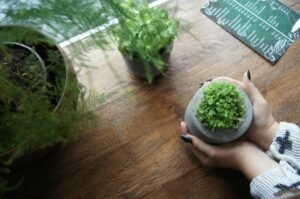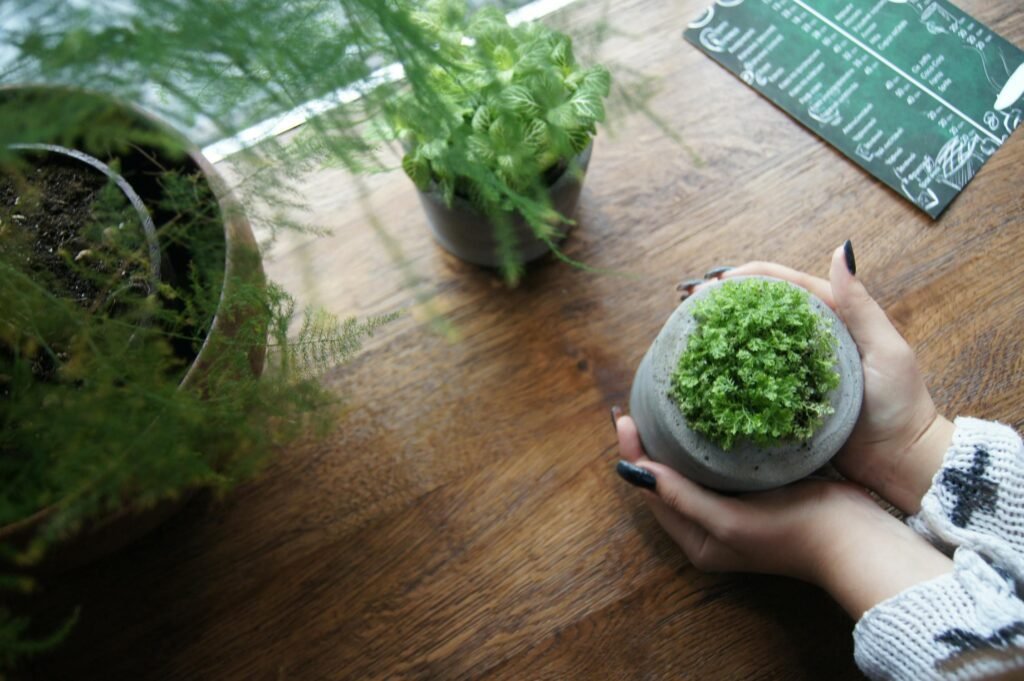Introduction:

- Greetings from the amazing realm of indoor herb cultivation! Whether you are an experienced cook or simply enjoy the scent of fresh herbs, growing your own indoor herb garden may be a gratifying and delightful hobby. We’ll walk you through everything you need to know in this in-depth guide to maintain healthy herbs in the comfort of your own kitchen all year long.
Outline:
- Why Grow Herbs Indoors?
- Choosing the Right Herbs
- Setting Up Your Indoor Herb Garden
- Caring for Your Indoor Herbs
- Common Issues and How to Troubleshoot
- Harvesting and Using Your Fresh Herbs
- Conclusion
Why Grow Herbs Indoors?
Let’s discuss the many advantages of indoor herb cultivation before getting our hands dirty (so to speak). First of all, cooking with fresh herbs at your disposal takes your dishes from amateur hour to the level of Top Chef. Furthermore, who doesn’t like how easy it is to grab a sprig of mint or basil whenever they need it rather than running to the store?
You have more control over the environment when you garden indoors. You don’t need to be concerned about erratic weather patterns or animals consuming your plants. It’s a tiny, personal green paradise that you can find within your house.
Choosing the Right Herbs
When it comes to indoor gardening, not all herbs are made equal. While some people prefer to pout in the shade, others flourish in warm, bright kitchens. Here are some delicious options for herbs that are hardy indoors:
Basil:
Basil is a timeless herb that enjoys warmth and sunlight. Ideal for connoisseurs of caprese salad and pesto.
Mint:
Who wants a fresh mojito?Mint is a drought-tolerant plant that needs regular watering and some shade.
Thyme:
We’re serious about thyme; this herb isn’t only for puns. Bright sunshine and well-drained soil are preferred by thyme.
Rosemary:
In the mood for something fancy? Rosemary is a culinary essential for savory meals since it likes sunlight and sufficient air circulation.
Think about the herbs you love to cook with when choosing which ones to plant in your indoor garden. If you enjoy Italian food, your go-to herbs may be oregano and basil. Mint and lemon balm make great additions to your garden for anyone who enjoy herbal teas and cool beverages.
Setting Up Your Indoor Herb Garden
After gathering your arsenal of plants, it’s time to furnish their comfortable indoor habitat. What you’ll need is as follows:
Containers: To avoid wet roots, select pots with drainage holes. Because the roots of herbs dislike standing water, a pot with drainage holes is necessary to ensure the health of the plants.
Potting mix : Select a potting mix that is designed specifically for herbs that drains well. Root rot can result from regular garden soil that is too dense and doesn’t drain properly in pots.
Location: Select a window sill where your herbs will receive enough of sunlight. Choose a window that faces south if at all feasible, as most herbs require at least six hours of sunlight per day to flourish.
Watering Can: When the top inch of soil is feeling dry to the touch, give your herbs a thorough drink. Thoroughly watering sparingly is preferable versus daily shallow watering.
Optional: If your kitchen gets a lot of shade, grow lights can help supplement natural light. Energy-efficient LED grow lights offer the complete spectrum of light required by plants for strong, healthy growth.
Think about putting herbs in your indoor herb garden together that require equal amounts of water and light. This facilitates their care and guarantees that each one of them has the ideal environment for growth.
Caring for Your Indoor Herbs
Even though they require little care, herbs nevertheless benefit from a little attention. Here are some expert pointers for maintaining the health and growth of your indoor garden:
Water Sensibly: The biggest cause of indoor herb death is over watering. Check the moisture content with your finger before watering again, as herbs prefer their soil to dry out a little bit between waterings.
Prune Frequently: To promote bushier, healthier plants, trim off any lanky growth. Make precise cuts slightly above a leaf node using pruning shears or clean, sharp scissors.
Apply fertilizer Use sparingly: Weak, floppy herbs might result from over fertilization. During the growing season, applying a diluted liquid fertilizer every few weeks should be sufficient. As an alternative, for a milder nutrient, you can use organic fertilizers like fish emulsion or compost.
Rotate for Balance: To make sure your herbs grow uniformly toward the sun, give them a quarter rotation each week. This promotes balanced growth and stops children from leaning or reaching toward the window.
Common Issues and How to Troubleshoot
Even the most committed parent of a herb can run into problems. Here are some frequent problems to resolve:

Yellow Leaves: This could indicate too much watering or not enough light. If necessary, change the way you water your plants and think about transferring them to a more sunny area.
Pests: Watch out for spider mites, whiteflies, and aphids. These pests can spread to other plants and weaken your herbs. Treat afflicted plants with insecticidal soap or neem oil, and isolate any severely contaminated herbs to stop the spread of the infestation.
Lack of light : causes lanky growth. Your herbs aren’t getting enough sunlight if they’re growing spindly or reaching toward the window. Think about moving your herbs to a brighter area or adding more grow lights.
Harvesting and Using Your Fresh Herbs
It’s finally harvest time—the moment you’ve been waiting for! As needed, trim off leaves, beginning with the outermost ones. This keeps your herbs lush and fruitful and promotes new growth. Any food, from salads and soups to marinades and desserts, can be improved with fresh herbs. Try different flavors and use your imagination; your palate will appreciate it!
When picking herbs, cut cleanly just above a leaf node with pruning shears or clean scissors. This keeps the plant from growing lanky and encourages it to create more growth. For optimal flavor, harvest herbs early in the day when their essential oils are at their highest concentration.
Conclusion
Here you have it: a comprehensive introduction to indoor herb planting. You will shortly be enjoying the fragrant benefits of your very own tiny herb garden with a little perseverance, love, and a sunny windowsill. So go ahead and start growing by getting your hands dirty (figuratively speaking)! Fueled by the finest herbs this side of the kitchen sink, your culinary adventures await.
Who’s prepared to whip up a storm now?


